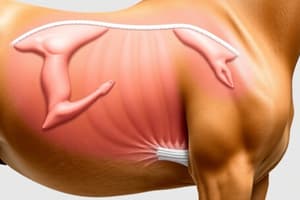Podcast
Questions and Answers
Which muscle tissue type is primarily responsible for regeneration after injury?
Which muscle tissue type is primarily responsible for regeneration after injury?
- All muscle types
- Skeletal muscle (correct)
- Smooth muscle
- Cardiac muscle
What is the primary function of the growth plates in the skeletal system?
What is the primary function of the growth plates in the skeletal system?
- Bone repair
- Bone lengthening (correct)
- Bone mineralization
- Joint lubrication
What role does the pancreas play in endocrine functions?
What role does the pancreas play in endocrine functions?
- Produces bile
- Breaks down fats
- Secretes insulin and glucagon (correct)
- Filters blood
Which type of liver cells are primarily involved in the phagocytosis of pathogens and dead cells?
Which type of liver cells are primarily involved in the phagocytosis of pathogens and dead cells?
In domestic animals, which anatomical feature is characteristic of the ovaries?
In domestic animals, which anatomical feature is characteristic of the ovaries?
What is the primary mechanism through which skeletal muscle exhibits higher regenerative potential?
What is the primary mechanism through which skeletal muscle exhibits higher regenerative potential?
At what age is the growth plate in cattle completely ossified?
At what age is the growth plate in cattle completely ossified?
Which statement about the pancreas is incorrect?
Which statement about the pancreas is incorrect?
Which phagocytic cells are primarily found in the liver?
Which phagocytic cells are primarily found in the liver?
In which species are the cortex and medulla of the ovaries located in reverse compared to most domestic animals?
In which species are the cortex and medulla of the ovaries located in reverse compared to most domestic animals?
Flashcards
Horse Kidney Shapes
Horse Kidney Shapes
Horse kidneys have unique shapes: the right is heart-shaped and the left is bean-shaped. Variations such as irregularly oval and lobated shapes are also seen.
Mare's Ovary Structure
Mare's Ovary Structure
Mare's ovaries have a bean-like shape due to the ovulation fossa, a region crucial for ovulation.
Pig Uterus Features
Pig Uterus Features
Pig uteri are characterized by a long cervix, short body, and long uterine horns.
Cattle Growth Plate Ossification
Cattle Growth Plate Ossification
Signup and view all the flashcards
Pancreatic Endocrine Function
Pancreatic Endocrine Function
Signup and view all the flashcards
Liver Phagocytic Cells
Liver Phagocytic Cells
Signup and view all the flashcards
Endothelium
Endothelium
Signup and view all the flashcards
Chicken Stomach
Chicken Stomach
Signup and view all the flashcards
Ruminant Dental Formula
Ruminant Dental Formula
Signup and view all the flashcards
Chicken Oviduct Shell Gland
Chicken Oviduct Shell Gland
Signup and view all the flashcards
Study Notes
Lung Structure
- Left lung consists of cranial and caudal lobes.
- Right lung has cranial, middle, and caudal lobes.
- Some variations exist, such as the presence of an accessory lobe in the right lung.
Kidney Structure in Horses
- Horse kidneys exhibit unique shapes: the right is heart-shaped and the left is bean-shaped.
- Abnormal shapes, like irregularly oval and lobated, are also observed.
Mare's Ovaries
- The bean-shaped appearance of a mare's ovaries is attributed to the ovulation fossa, a specific region important for ovulation.
Uterine Characteristics in Domestic Animals
- Pigs have a uterus characterized by long cervix and short body with long horns.
- Uterus develops from paramesonephric ducts, similar to salpinx and vagina.
- Cervical folds vary by species: longitudinal in mare, cat, and dog; circular in pig; interdigitating in cow.
- Uterine wall features caruncles for attachment of embryonic cotyledons during pregnancy.
Pancreatic Duct Structures
- Domestic animals present varied pancreatic duct structures, which are crucial for accurate veterinary diagnosis.
Growth Plate Ossification
- Cattle growth plates completely ossify by 20 months of age.
Pancreas Functions
- The pancreas' primary endocrine functions reside in the Islets of Langerhans.
- Beta cells secrete insulin in response to hypoglycemia.
- D cells inhibit secretions from Alpha and Beta cells.
- Digestive enzymes are produced by pancreatic acinar cells.
Liver Phagocytic Cells
- Kupffer cells are the primary phagocytic cells found in the liver.
Endothelium
- Special simple squamous epithelium lining blood vessels, including the heart, is known as endothelium.
Red Blood Cell Size
- Caprine species have the smallest average size of red blood cells compared to equine, canine, and bovine species.
Ovarian Structure in Domestic Animals
- In most domestic animals, the cortex is peripheral and the medulla is central.
- Sows are unique as their cortex and medulla are arranged in reverse.
Estrous Cycle Stages in Bitches
- Vaginal cytology with cornified cells and pyknotic nuclei indicates the estrus stage.
Ovarian Follicle Events Sequence
- The correct sequence of ovarian follicle development is Graafian follicle > corpus luteum > corpus hemorrhagicum.
Heart Conditions in Pigs
- Ascites in piglets often suggests right side heart failure is the most affected area.
Rodent Uterus Structure
- Rodent and rabbit uteri are characterized by completely separated uterine horns and separate cervices, described as duplex.
Ruminant Dental Formula
- Ruminants typically have a dental formula of 0/3, 0/1, 3/3, 3/3.
Chicken Digestive System
- Chickens possess a proventriculus, which is the true stomach where digestive enzymes are secreted.
Chicken Oviduct Shell Gland
- The uterus, part of the chicken oviduct, is responsible for adding the shell to the egg.
Lack of Seminal Vesicles
- Cats and horses lack seminal vesicles, while cattle and goats possess them.
Notocord Derivatives
- The intervertebral disc arises from the notochord during embryonic development.
Cattle Placentation
- Cattle exhibit multicotyledonary, syndesmochorial placentation patterns and are classified as deciduate.
Embryonic Cleaving Events
- Cleavage refers to embryonic mitotic division where total size remains constant across daughter cells.
Studying That Suits You
Use AI to generate personalized quizzes and flashcards to suit your learning preferences.




